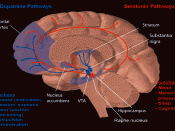Bulimia Nervosa is a serious, potentially life threatening eating disorder characterized by a cycle of bingeing and compensatory behaviors such as self induced vomiting designed to undo or compensate for the effects of binge eating. A binge can be consuming calories ranging from 1,000 to 60,000 calories in a 1-2 hour span. Feelings of panic and guilt will set this individual to soon realize they must purge the calories by vomiting, excessive use of diuretics and laxatives, fasting or excessive exercise.
This disorder occurs in 80% of women in the Unites State, 1% to 2% of adolescents and young women. The typical person with bulimia is well educated, inn her early twenties, and close to their ideal body weight. Men also suffer from bulimia. More men suffer from bulimia than from anorexia and on the rise with increasing numbers. The reason why men develop this eating disorder is not very different from why a female develops one.
The age onset for development of an eating disorder is late for men than women.
Sign of someone with a bulimic disorder include binging and purging, secretive eating, weight fluctuations, someone who visits the bathroom after meals, self criticism and tooth decay. A person who has preoccupation with food, excessive and compulsive exercise regimes, avoids eating in public and in front of others, scarring on knuckles of fingers and has broken vessels in their eyes show symptoms of someone with bulimia. Bulimia Nervosa can cause many medical complications and sometimes lead to death. Binging and purging tears the lining of the stomach, cause a chronic sore throat, and causes erosions of the teeth and eruption of the esophagus. This disorder leads to gastrointestinal problems, chronic kidney problems, cause dehydration, vitamin and mineral deficiencies and affects your fluid and electrolyte balances.
There are many...


